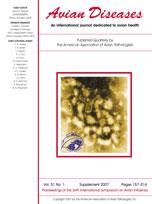From November 2003 to June 2004 an epidemic of high pathogenicity avian influenza (HPAI) virus of subtype H7N3 affected the major layer and broiler-breeder raising areas of the country. This was accompanied by an outbreak of low pathogenicity avian influenza (LPAI) virus of type H9N2 in broilers and layers, which continued during 2005. Subsequently, in February 2006 avian influenza virus (AIV) subtype H5N1 was for the first time found in two isolated commercial flocks in this country. The HPAI outbreak of 2003–2004 was eventually overcome by enforcing biosecurity measures, controlling poultry movements, using inactivated vaccines, and introducing a comprehensive AI surveillance network throughout the country. However, similar measures undertaken to control H9N2 outbreaks have not been successful in the affected areas, with continuing increased mortality and heavy production losses in broilers and layers, respectively. A similar strategy has been devised to combat the spread of newly introduced H5N1 HPAIV. The description of these outbreaks and the results of the control strategy are reported here.
How to translate text using browser tools
1 March 2007
Avian Influenza in Pakistan: Outbreaks of Low- and High-Pathogenicity Avian Influenza in Pakistan During 2003–2006
K. Naeem,
N. Siddique,
M. Ayaz,
M. A. Jalalee
ACCESS THE FULL ARTICLE

Avian Diseases
Vol. 51 • No. s1
March 2007
Vol. 51 • No. s1
March 2007
avian influenza
H5N1
H7N3
H9N2
Outbreaks
surveillance




